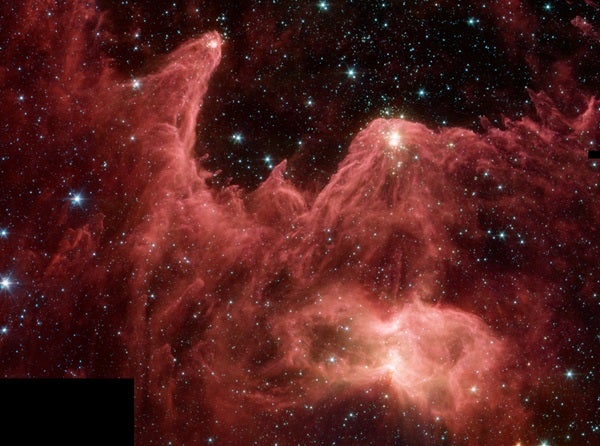Dust may be a nuisance around the house, but it plays a vital role in the formation of the key ingredient for life on Earth — water — according to researchers at Heriot-Watt University in Edinburgh, Scotland. The results from pioneering experiments to solve one of the mysteries of interstellar space, where did all the water come from, was presented by Heriot-Watt’s Victoria Frankland at the Royal Astronomical Society National Astronomy Meeting in Glasgow Wednesday, April 14.
“We think that the Earth’s water was delivered by comets during the early stages of Earth’s history and that comets were formed from interstellar material left over after the birth of the Sun, but the next step back has been unclear,” said Frankland.
Water is relatively abundant in the interstellar medium and hydrogen atoms are extremely common, but there is a problem with the other vital ingredient for H2O. Gas phase reactions that can take place in the interstellar medium are limited by the low temperatures and pressures. Experiments show that it is possible for hydrogen atoms to combine with molecules of oxygen (O2) or ozone (O3) under the conditions of the interstellar medium. However, observations by recent satellite missions have detected very little gaseous molecular oxygen, and ozone has never been detected at all in these regions of space. On the other hand, atomic oxygen (O) is quite plentiful, but gas phase reactions between hydrogen and atomic oxygen can’t account for the amount of water observed. Even the observed quantities of atomic oxygen suggest that some is “missing” in star-forming regions compared to the rest of interstellar space.
Frankland and her colleagues at Heriot-Watt believe the dust grains, which make up about 1 percent of the interstellar medium, hold the key by providing a surface that helps reactions take place. In addition, some molecules remain stuck to the surface, building up an icy coating over time. This coating, which is mainly water ice, can then play a role in reactions.
The team at Heriot-Watt has pioneered surface science techniques to evaluate experimentally exactly how such reactions might occur.
However, the temperatures in interstellar space can reach just a few degrees above absolute zero, so recreating the conditions in the laboratory has been a challenge.
“Our experiments rely on being able to reproduce in the laboratory the very low pressures and low temperatures of these star-forming regions.
We set up our experiments in a vacuum chamber and cool it down to –450° Fahrenheit (– 268° Celsius), then use surface sensitive techniques to explore the physical and chemical behavior of oxygen atoms and molecules on the surfaces of dust and ice grains,” said Frankland.
Initially, the experiments have been looking at how the surfaces of dust particles affect the reactions of oxygen in its various forms in order to eliminate other water formation reactions. However, the ultimate aim of this research will be to combine atomic beams of oxygen and hydrogen to study in situ water formation on a grain surface.
“These initial experiments are having some interesting results in that they are allowing us to look at how the ice coating develops on the dust particles,” said Frankland. “It appears that oxygen atoms may become trapped inside the icy mantles. We need to do more work, but it could be that our experiments might help solve the mystery of the missing atomic oxygen as well as where the water has come from.”










